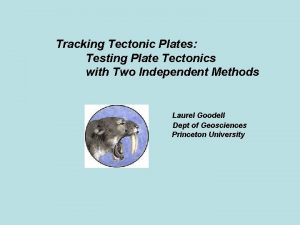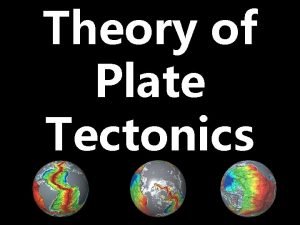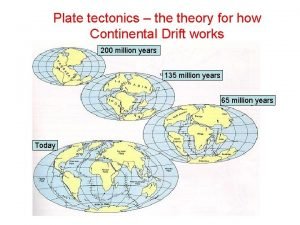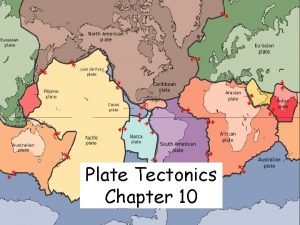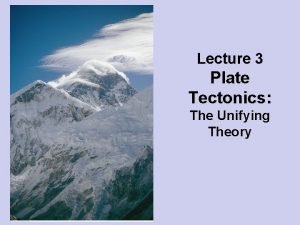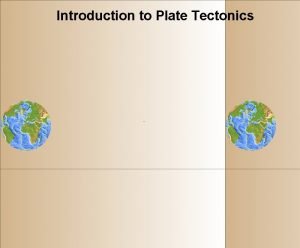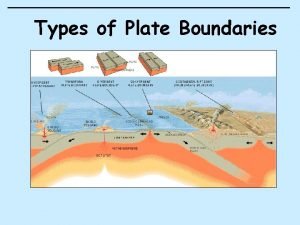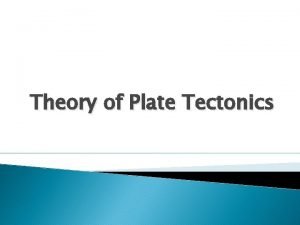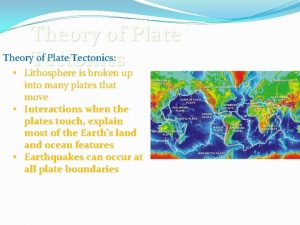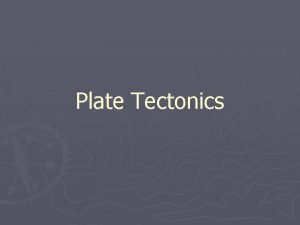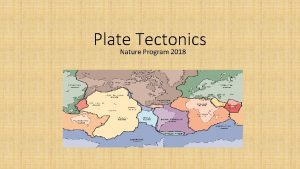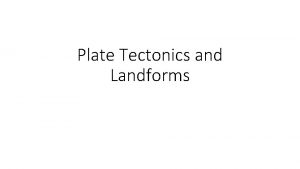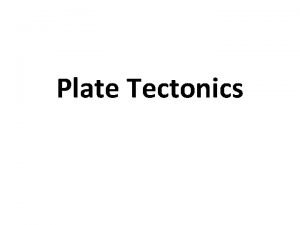Plate Tectonics Plate tectonics Theory of plate tectonics










- Slides: 10

Plate Tectonics

Plate tectonics • Theory of plate tectonics explains the formation, movement, and subduction of Earth’s Plates.

Continental Drift • Alfred Wegener believed the crust of the earth moved as early as the 1800 s, but he couldn’t explain what made them move. He called his idea CONTINENTAL DRIFT. He thought the plates moved because of 4 reasons:

Continental Drift • # 1 - the shapes of the continents look like they fit together like a puzzle. • # 2 - Fossils on continents beside each other match up. • # 3 - Rock types and Mountain ranges on continents beside each other match up. • # 4 - Warm climate fossils are found in Antarctica, and there is evidence of glaciers in places that are now tropical. A possible explanation is the continents moved.

Movement • The lithosphere is broken into sections called PLATES. The plates get carried along as the asthenosphere moves due to convection currents, like a raft in a river. • At subduction zones, gravity pulls one part of the plate down into the mantle. The rest of the plate slowly follows

Formations • As plates move, they collide, pull apart, or grind past each other producing major changes on the earths surface • When tectonic plates collide they form many physical land features such as: – – Volcanoes Mountain Ranges Deep Ocean Trenches Rift Valley

Types of Boundaries • A plate boundary is where one plate meets another plate. • Divergent Boundaries • Convergent Boundaries • Transform Boundaries

Convergent Boundaries • There are two types of Convergent Boundaries: – A. Subduction: when one plate is more dense than another, the more dense plate goes underneath the less dense plate. – B. Collision: when the 2 plates are the same material. When they hit, they both buckle up – (this makes mountains) a higher e

Divergent Boundaries • When two plates move apart. • Features: – In continents: – Rift Valley, Volcanoes, Earthquakes – In oceans: – Mid-Ocean Ridge, Volcanoes, Earthquakes

Transform Boundaries • When two plates slide past each other. • Features: Earthquakes
 Plate tectonic theory vs continental drift
Plate tectonic theory vs continental drift Plate tectonic theory vs continental drift
Plate tectonic theory vs continental drift Plate motion calculator
Plate motion calculator Plate tectonics theory states that
Plate tectonics theory states that Continental drift vs plate tectonics theory
Continental drift vs plate tectonics theory Summarize the theory of plate tectonics
Summarize the theory of plate tectonics Types of volcanoes
Types of volcanoes Unifying theory of plate tectonics
Unifying theory of plate tectonics Theory of plate tectonics
Theory of plate tectonics Plate tectonics vs continental drift
Plate tectonics vs continental drift Plate boundaries types
Plate boundaries types


